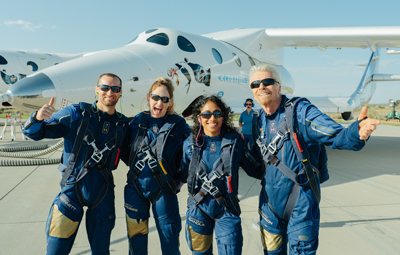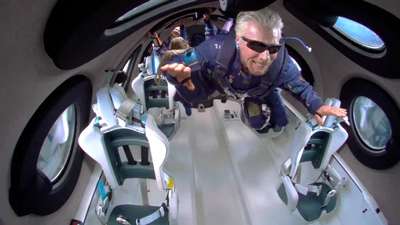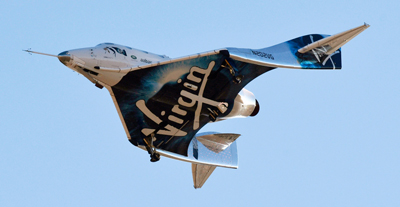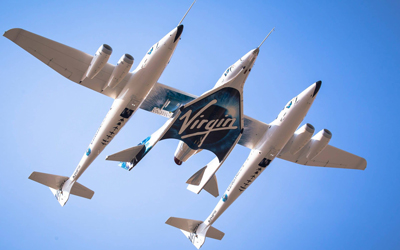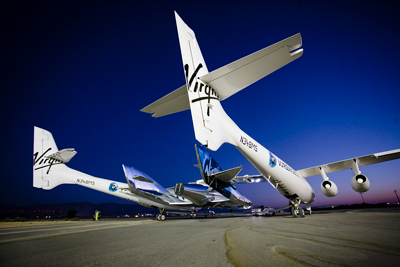Virgin Galactic
This is a spaceflight company founded by Richard Branson and the Virgin Group. It is headquartered in California, and operates from New Mexico. The company is developing commercial spacecraft and aims to provide suborbital spaceflights to space tourists. Virgin Galactic’s suborbital spacecraft are air launched from beneath a carrier aeroplane known as White Knight Two. Virgin Galactic’s maiden spaceflight occurred in 2018 with its VSS Unity spaceship.
- On 13 December 2018, VSS Unity achieved the project’s first suborbital space flight, VSS Unity VP-03, with two pilots, reaching an altitude of 82.7 kilometres.
- On 11 July 2021, the company founder Richard Branson and three other employees rode on a flight as passengers, marking the first time a spaceflight company founder has travelled on his own ship into outer space.
- In February 2022, Virgin Galactic announced that it opens ticket sales to the public. The price of a reservation is $450,000.
Structure and History
Formation and early activities
- Virgin Galactic was founded in 2004 by British entrepreneur Sir Richard Branson.
The Spaceship Company
- The Spaceship Company (TSC) was founded by Richard Branson through Virgin Group (which owned 70%) and Burt Rutan through Scaled Composites (which owned 30%) to build commercial spaceships and launch aircraft for space travel.
Aims
Overview of the flights to be developed
- The spacecraft initially called SpaceShipTwo is planned to achieve a suborbital journey with a short period of weightlessness. Carried to about 16 kilometers, or 52,000 ft, underneath a carrier aircraft, White Knight II, after separation the vehicle would continue to over 100 km (the Kármán line, a common definition of where “space” begins). The suborbital flight itself would be only a small fraction of that time, with weightlessness lasting approximately 6 minutes.
Development Operations
Commencement of sub-space test flights
- In July 2008, Richard Branson predicted the maiden space voyage would take place within 18 months.
- In October 2009, Virgin Galactic announced that initial flights would take place from Spaceport America “within two years.” Later that year, Scaled Composites announced that White Knight Two’s first SpaceShipTwo captive flights would be in early 2010. Both aircraft did fly together in March 2010.
- On 7 December 2009, SpaceShipTwo was unveiled at the Mojave Spaceport. Branson told the 300 people attending, each of whom had booked rides at $200,000 each,
- By February 2012, SpaceShipTwo had completed 15 test flights attached to White Knight Two and an additional 16 glide tests, the last of which took place in September 2011.
- A rocket-powered test flight of SpaceShipTwo took place on 29 April 2013, with an engine burn of 16 seconds duration.
- SpaceShipTwo’s second supersonic flight achieved a speed of 1,100 mph for 20 seconds.
- In addition to the suborbital passenger business, Virgin Galactic intended to market SpaceShipTwo for suborbital space science missions and market White Knight Two for “small satellite” launch services.
- On 14 May 2013, Richard Branson stated the first public flight of SpaceShipTwo, which had again been rescheduled, this time to December 25, 2013. The third rocket-powered test flight of SpaceShipTwo took place on 10 January 2014 and successfully tested the spaceship’s Reaction Control System (RCS) and the newly installed thermal protection coating on the vehicle’s tail booms.
- In February 2014, cracks in WhiteKnightTwo, where the spars connect with the fuselage, were discovered during an inspection conducted after Virgin Galactic took possession of the aircraft from builder Scaled Composites.
VSS Enterprise
- At 10:51 PST 31 October 2014, the fourth rocket-powered test flight of the company’s first SpaceShipTwo craft, VSS Enterprise, ended in disaster, as it broke apart in mid-air, with the debris falling into the Mojave desert in California.
- Investigations found that the engine and propellant tanks were intact, showing that there had not been a fuel explosion. Telemetry data and cockpit video showed that instead, the air braking system appeared to have deployed incorrectly and too early, and whether the craft’s position in the air and its speed somehow enabled the tail section to swing free on its own.
VSS Unity
- Following the crash of VSS Enterprise, the replacement SpaceShipTwo named VSS Unity was rolled out on 19 February 2016.
- Test flights were set to begin after ground tests completed in August 2016. VSS Unity completed its first flight, a successful glide test, in December 2016.
- On 22 May 2021, VSS flew its sixth powered test flight reaching an altitude of 89km This suborbital flight marked the first ever human space flight from New Mexico.
- On 11 July 2021 fully crewed with two pilots Dave Mackay and Michael Masucci and the four passengers were Richard Branson, Beth Moses, Colin Bennett and Sirisha Bandla.
- On 14 October 2021, Virgin Galactic announced that an upgrade program for Unity and Eve (launch vessel) would begin, delaying future commercial flights to mid 2022.
VSS Imagine
- VSS Imagine, was rolled out on 30 March 2021 and it was indicated there is ground testing to do before glide test flights should commence not earlier than Summer 2021.
Aircraft and Spacecraft
Mother-ships
White Knight Two
- The White Knight Two is a special aeroplane built as the mother ship and launch-platform for the spacecraft SpaceShipTwo and the uncrewed launch vehicle LauncherOne.
- The mother-ship is a large fixed-wing aircraft with two hulls linked together by a central wing. Two aircraft are planned – VMS Eve and VMS Spirit of Steve Fossett.
- On May 22, 2021 Mother-ship Eve was used to carry VSS Unity to a launch altitude of 44,000 feet.
Generation II mothership
- Virgin Galactic plans to have generation 2 mother-ships ready for 2025, for the next-generation Delta-class It partnered with Boeing’s Aurora Flight Sciences to design and build the next generation of mother-ship.
Spaceships
SpaceShip Two
- Richard Branson unveiled the rocket plane on 7 December 2009, announcing that, after testing, the plane would carry fare-paying passengers ticketed for short duration journeys just above the atmosphere.
- Virgin Group would initially launch from a base in New Mexico before extending operations around the globe. Built from lightweight carbon-composite materials and powered by a hybrid rocket motor, SS2 is based on the Ansari X Prize-winning SpaceShipOne concept – a rocket plane that is lifted initially by a carrier aircraft before independent launch. SS1 became the world’s first private spaceship with a series of high-altitude flights in 2004.
- SS1 successor is twice as large, measuring 18m in length; whereas SpaceShipOne could carry a single pilot and two passengers, SS2 will have a crew of two and room for six passengers.
SpaceShipTwo’s Projected Performance
- SpaceShipTwo was designed to fly to a height of 110 km,going beyond the defined boundary of space (100 km) and lengthening the experience of weightlessness for its passengers. The spacecraft would reach a top speed of 4000 km/h.
- On 23 May 2014, Virgin Galactic announced that they had abandoned use of the Sierra Nevada Corporation (SNC) nitrous-oxide-rubber motor for SpaceShipTwo; on 24 July 2014.
- To re-enter the atmosphere, SpaceShipTwo folds its wings up and then returns them to their original position for an unpowered descent flight back onto the runway. The craft has a very limited cross-range capability, and until other planned spaceports are built worldwide, it has to land in the area where it started.
- There have been a series of delays to the SS2 flight test vehicle becoming operational. , amidst repeated assurances from Virgin Galactic marketing that operational flights were only a year or two out.
SpaceShip Three
- SpaceShipThree is an evolved version of SpaceShipTwo.
Delta-class spaceship
- Virgin Galactic plans to have its third generation spaceship, the Delta class, ready for 2025, along with the next generation of mother-ship. The Delta class is to be functionally the same as the Space Ship III class, but it has been redesigned for higher production volumes.

